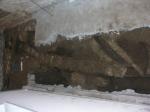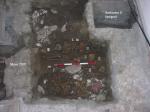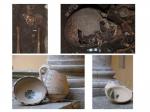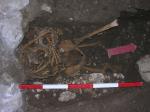Summary (English)
The laying of a new floor provided the occasion for an investigation of the first phases of the life of the monastic complex. The results confirmed that the function of the area (trench II) had been the same since the monastery’s foundation. The C14 dating of the burials dated them to the end of the 1200s-first half of the 1300s. At this time, the church had a single nave whose dimensions can be identified from the drawing in the Platea manuscript (see below), with the 16th century extension. The funerary use of the cloister from the time of the foundation was attested by the discovery of 18 intact burials in earth graves, associated with numerous reductions generally overlying skeletons in primary deposition. The funerary use of the area is known from the time the friars took up residence following the Assisiate (1221-1222) as confirmed by the C14 dating (mid-end of the 13th century) of another four skeletons, of which two partially destroyed by the south wall of the ancient cloister.
There were also two double burials among the single ones: one containing adults, dating to the pre-monastery phase, the other datable to the full 14th century and containing a double child burial with each individual wrapped in a cloth shroud. Only one of the individuals was female. The age at death was generally between 18 and 30 years: the oldest had reached the age of 60 and the youngest was only 42 months old. The vicinity of the burials ad locum (hermitage) identifies the area with the paradisus. The area in front of the door into the hermitage was the most used and the underground chamber below may be identified as a privileged burial chamber, masonry-built with two levels of deposition or a burial chamber whose lower level functioned as an ossuary and the upper level was used for primary depositions.
The excavations uncovered the system that drained the rainwater from the courtyard towards the exterior of the cloister: channels created in dumped earth, associated with materials (pottery, glass and a Federician coin) that date the deposit to the period of the 13th-14th century building. The cloister’s construction caused the abandonment and partial demolition of earlier walls, whose interpretation remains perplexing and whose dating to within the 1200s was confirmed by the presence of red-banded pottery in the abandonment layers.
The grave goods brought up various questions: could the presence of a lead glazed and painted bowl (c. 1250) identify the deceased as a preacher who came from Montella amongst the followers of San Francesco or rather as a beggar? Are the iron nails and shoe buckles, found in some graves, indicative of the job or social status of the deceased? Could the discovery of a sheet of wood under a body be indicative of a funerary ritual?
- Simone Schiavone - Università degli Studi “Suor Orsola Benincasa” di Napoli
Director
- Alfonso Quagliariello, Soprintendenza ai Beni Architettonici Paesaggistici Storico-artistici
Team
- Maria Fariello - Soprintendenza Archeologica SA-AV-BN
- Lucia Portoghesi
- Pizzano Ciriaco - Soprintendenza Archeologica SA-AV-BN
- Raffaella Cecere - Soprintendenza Archeologica SA-AV-BN
- Marielva Torino - Università degli Studî Suor Orsola Benincasa Napoli
Research Body
- Duke University
- University of Southern Denmark, Odense (Instutute of Forensic Medicine; Istitut for Fysik og Kemi)
Funding Body
- Comunità dei frati del Convento San Francesco a Folloni e famiglia Lenzi di Bagnoli Irpino





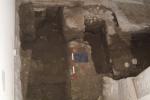
![Download [PDF]](/excavation/skins/fasti/images/results/download_sml.png)
